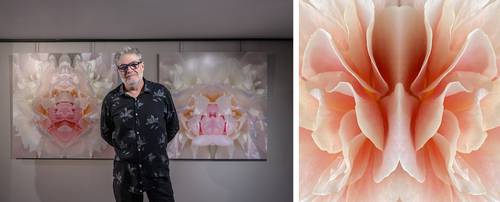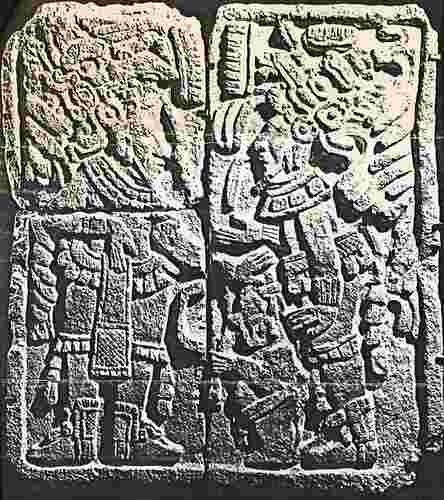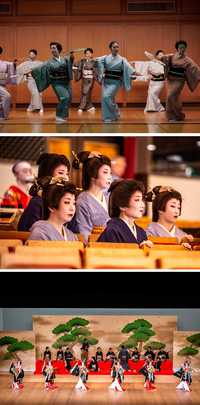Artist Tina Girouard returns to the Tamayo Museum after 42 years.

Artist Tina Girouard returns to the Tamayo Museum after 42 years.
SIGN-IN brings together 256 pieces and offers an intimate look at home, work and caregiving // A key figure in the Soho scene, she was the first woman to exhibit there in 1983
▲ Tina Girouard sweeps under a pier on the Brooklyn Bridge; three fabric panels were mounted on this image: Child , House , and Contradictory Evidence . Photo by Luis Castillo
Eirinet Gómez
La Jornada Newspaper, Thursday, May 22, 2025, p. 2
After 42 years, the work of multidisciplinary artist Tina Girouard (1946-2020) returned to the Museo Tamayo Arte Contemporáneo with SIGN-IN , an exhibition that brings together 256 pieces and offers an intimate look at themes such as language, home, work, and care. A key figure in the SoHo art scene in New York during the 1960s and 1970s, Girouard was the first woman to exhibit there in 1983.
“Although Girouard was a pioneer in performance , installation, and textile art—practices that helped establish an artistic canon in New York—because she was a woman, her work was overlooked for decades. This exhibition honors her creative work and the importance of remembering women artists who influenced the way we understand art today,” said Manuela Moscoso, curator of the exhibition.
A panel of 110 graphite-on-paper works, titled "DNA ," opens the exhibition: each panel contains a different abstract or figurative figure; this is followed by panels of baked and pigmented fabric in which the artist combines different textile patterns, interspersed with personal symbols.
Tina Girouard's work has often been described as decorative and domestic art: since she is a woman and works with textiles, it is assumed that her work is domestic. But that is a very reductionist interpretation. If someone delves deeper into her creative process, they will notice much more complex and relevant aspects
, Moscoso stated at the beginning of the tour.
One of the exhibition's most powerful features is the use of the exhibition space as part of the work: some walls are completely covered with large-scale printed photographs that function as background and context for the pieces. In one of these, Tina Girouard is seen sweeping under a pier on the Brooklyn Bridge; three fabric panels were mounted over this image: Child , House , and Contradictory Evidence.
We wanted to create this depth that she speaks about through language, not exclusively through domesticity
, Moscoso explained.
The installation also features letters, notebooks with reflections on the creative process, photographs of her performances and scenes from her daily life with friends in the southern neighborhoods of New York, as well as notebooks where she recorded the meanings she gave to the symbols she captured in her textiles.
A prominent space used at that time allows visitors to delve into his personal and artistic universe. Textile sequences are projected on several screens, enhancing the exhibition's sensorial experience. A stamped steel panel is also on display.
Pioneer of video art
There are videos where she is seen washing fabrics, which evokes the idea of care, of maintenance. She began working with video when it was just emerging as a medium, and that's still not fully recognized. She was a pioneer of video art
, the curator added.
SIGN-IN has been presented at institutions such as the Ogden Museum of Southern Art in New Orleans and the Center for Art, Research and Alliances (CARA) in New York. For its arrival at the Museo Tamayo, a special section was included commemorating the 1983 exhibition, titled Vámonos a México, with photographs of the installation and stationery from that era.
"In New Orleans, where she lived, the approach was much more chronological, telling her story from birth to death. In New York, the spaces were smaller, and it was decided not to show her work on the restaurant Food, which she created in collaboration with Gordon Matta-Clark.
Here, we've brought in many more works because the spaces are larger. We also made an effort to tell the stories and contextualize the pieces through gallery texts and explanatory labels
, Moscoso noted.
Among the most outstanding pieces are Dambala (1991) and Under a Spell (1992), made in Haiti in collaboration with the artist Antoine Oleyant, with glass beads, sequins, acrylics and other materials hand-sewn on canvas.
They were constructed from a hybrid visual language of symbols and narratives that referenced their respective cultural symbolism
, the exhibition card states. Girouard learned the Haitian spiritual lexicon of the gods from Oleyant and shared with him images derived from his family's migration from Nova Scotia, Canada, to Haiti, and finally to southeastern Louisiana.
For Amy Bonwell, the artist's niece, who was present at the opening of the collection, bringing Tina back to the Museo Tamayo is a dream come true: When she was born in Louisiana, my grandparents took her to San Antonio, Texas, where there is a very strong Mexican culture. I think when they offered her that exhibition in 1983, she felt comfortable because she was already familiar with Mexican culture and loved it deeply. It must have been very exciting for her to come to the source of that culture, which she knew from Texas
.
Bonwell said that before these exhibitions, Girouard's work was stored in a climate-controlled cellar. She kept much of it because she knew its value. She believed in herself so much, even if the art world had forgotten her. And now we can enjoy that. It's very exciting to see her work appreciated, because I know that would make her very happy
.
Organized by the Rivers Institute for Contemporary Art & Thought, SIGN-IN is the result of a four-year investigation. It opened yesterday and will remain open to the public until September 14 at the Museo Tamayo (51 Reforma Avenue, Mexico City).
Hugo Maza's exhibition reveals a delicate balance between order and chaos
Photographs and digital paintings of flowers envelop the viewer in a sensory experience

▲ Hugo Maza presents Subconscious Bloom , open to the public until Saturday at the Picci Fine Arts gallery. Photo courtesy of the venue .
Daniel López Aguilar
La Jornada Newspaper, Thursday, May 22, 2025, p. 3
Flowers don't ask permission to emerge; they sprout even in the deepest corners of the mind. This is what happens in Subconscious Bloom , an exhibition by artist Hugo Maza that transcends the visible to envelop the viewer in a sensorial experience.
The collection, presented at the Picci Fine Arts gallery, brings together 13 pieces: 10 photographs that make up the series that gives the exhibition its name and three digital paintings that comprise the Rouge trilogy. Together, they trace a cartography of organic sensuality, in which geometry and symmetry intertwine with the softness of peonies, roses, and carnations.
But beyond this carefully curated aesthetic lies a deeply human story: that of a son who accompanied his mother during the darkest days of pandemic confinement.
My mother was battling Alzheimer's. During that time, I took care of her, and we would go out to the garden to look at the flowers
, Maza (Mexico City, 1962) explained in an interview with La Jornada .
She was a florist and landscaper. She taught me the different scientific, popular, and regional names for each species. It was an exercise in memory, but also in love.
What began as an act of affection took root in silence, giving way to a conscious visual search.
In those calm moments, I began to explore textures and geometries. It was an experiment, and little by little, the discoveries surprised me
, Maza added.
These investigations are captured in images where reflected symmetry dialogues with the natural softness of the petal. The intention is to move away from simply reproducing the environment and instead unfold it: to make each flower a metaphor for desire, a delicate balance between order and chaos.
The pieces are born from a hybrid process: digital photography, sometimes with a camera, sometimes with a cell phone, because the right flower appears when it wants to, not when you look for it
, and meticulous editing with multiple applications.
At this intersection between the technical and the sensitive, the artist reaffirms his role as an active gaze: "Some say that the digital doesn't have the value of the analog. But I am the analogical part: the one who observes, decides, and transforms. The digital is merely a tool
."
With a solid track record as an audiovisual director and producer, Maza sees in these creations an extension of his visual language and, at the same time, a deeply intimate twist.
“ Subconscious Bloom is complemented by Rouge , which represents an emotional counterbalance and expressive expansion. Symmetry can feel rigid; Rouge is the opposite: a more direct, visceral release, more connected to the body than to reason.
Each flower is a witness and protagonist of a story that speaks of fragility, but also of resilience. I want them to provoke emotions, sensations, and discussions
, concluded Hugo Maza.
The Subconscious Bloom exhibition can be visited today and tomorrow from 9 a.m. to 7 p.m. and on Saturday from 10 a.m. to 2 p.m. at the Picci Fine Arts gallery (Alpes 700a, Lomas de Chapultepec neighborhood, Miguel Hidalgo borough). Admission is free, but scheduling a visit is recommended by emailing [email protected]
Final destination of repatriated Mayan piece in museum of the Puuc region, in Yucatán

▲ In collaboration with a museum in the United States, the location of one half of the limestone bas-relief panel is being investigated. Photo: Jorge Ángel Pablo García
Reyes Martínez Torrijos
La Jornada Newspaper, Thursday, May 22, 2025, p. 3
The final destination of the Mayan piece that the National Museum of Mexican Art (NMMA) in Chicago will return to our country will be a museum in the Puuc region of Yucatán, after it has been displayed at the U.S. site for at least a year and then at the National Museum of Anthropology for another period, confirmed Diego Prieto, head of the National Institute of Anthropology and History.
In an interview with La Jornada , the official said that, in collaboration with the United States museum, they are investigating where the other half of the low-relief panel carved on limestone in the late classic or terminal classic period (between the years 600 and 800 AD) is located.
Prieto emphasized the importance of these pieces being as close as possible to the communities that can assign them value and active symbolism, from the perspective of the cultural affirmation of the communities and peoples that come from these original civilizations
.
The anthropologist expressed optimism about continuing the repatriation of Mexican heritage artifacts, which so far this six-year term has resulted in the restitution of approximately 2,000 cultural, archaeological, historical, and ethnographic objects.
He stated that they are intensifying efforts, such as the one to repatriate the Codex Bourbon, which is currently housed in the Library of the National Assembly in Paris. He reported that he met with Elena Espinosa Morales, secretary of the Culture and Cinematography Committee, to respectfully suggest to the Chamber of Deputies that the request be strengthened from one legislative session to another
.
He said they will try to update the request from the Executive branch
, which was made in 2020, through a letter from President Andrés Manuel López Obrador, requesting restitution.
Prieto reported that there will be a ceremony today with the Italian Minister of Foreign Affairs at the National Museum of Anthropology, where a small sample of the latest pieces returned from that nation will be presented.
Douglas Massey, Princess of Asturias Award for Social Sciences
The American demographer is an expert in migration phenomena.
Armando G. Tejeda
Correspondent
La Jornada Newspaper, Thursday, May 22, 2025, p. 4
Madrid. Sociologist and demographer Douglas Massey, an expert on migration phenomena, was awarded the Princess of Asturias Award for Social Sciences in recognition of his intellectual work, which has facilitated the understanding of international migration
. Born in the United States in 1952, Massey has published numerous essays and books, in addition to creating vital projects such as the Mexican Migration Project and the Latin American Migration Project, in collaboration with Jorge Durand, which have provided valuable data on migration patterns in Latin America.
The jury for the award was made up of academics, intellectuals and writers such as Javier Echeverría, Marta Elvira Rojo, Juan Pablo Fusi Aizpurúa, Pablo Hernández de Cos, Silvia Iranzo Gutiérrez and Ricardo Martí Fluxá, among others. The choice of Massey was justified in a statement in which it was noted that , based on the conception of man as a migratory species and through an outstanding research career, Douglas Massey has made fundamental contributions to the understanding of international migration and its consequences on urban segregation and social stratification, processes accentuated by globalizing dynamics
.
They also explained that "with a broad impact on the social sciences as a whole, Massey has constructed a theoretical model of the most demanding academic rigor, allowing us to interpret contemporary societies—in which migration has become a structural factor—with a calm, rational, and empathetic perspective."
Massey was nominated for the award by Alejandro Portes, 2019 Princess of Asturias Laureate for Social Sciences, and was chosen from a field of 40 candidates from 15 different nationalities. The American sociologist earned his bachelor's degree in sociology, psychology, and Spanish from Western Washington University in 1974. He subsequently completed his master's degree in 1977 and his doctorate in sociology in 1978 from Princeton University.

▲ The sociologist has also created projects such as the Mexican Migration Project and the Latin American Migration Project. Photo courtesy of the Princess of Asturias Award.
He began his teaching career at the latter institution, where he is currently the Henry G. Bryant Professor of Sociology and Public Affairs. He has also served as Director of the Office of Population Research and the Population Studies Program at the same university.
Academic rigor with an accessible approach
Recognized for his multidisciplinary approach, Massey has made significant contributions in areas such as international migration, residential segregation, and social stratification. His work has been fundamental, according to experts, to understanding the dynamics of international migration and urban segregation, combining academic rigor with an accessible approach that has influenced both academia and public policymaking.
Throughout his career, he has held prominent positions in various academic organizations and has received numerous honorary doctorates, including honorary doctorates from the University of Pennsylvania and the Ohio State University. He is a member of the United States National Academy of Sciences, the American Academy of Arts and Sciences, the American Philosophical Society, and the European Academy, among other institutions.
He has received numerous awards, including the World Cultural Council of Mexico's Recognition of Outstanding Merit Award in 2008 and the Bronislaw Malinowski Prize from the Society for Applied Anthropology, awarded with Jorge Durand for their collaborative work on the Mexican Migration Project, among others.
This was the third of eight Princess of Asturias Awards presented this year, the 45th edition. Previously, the Princess of Asturias Award for Communication and Humanities was awarded to the German philosopher and essayist of South Korean origin Byung-Chul Han, and the Princess of Asturias Award for Literature was awarded to the Spanish writer Eduardo Mendoza. The awards will be presented, as is the case every year, at an official gala at the Campoamor Theater in Oviedo.
AFP
La Jornada Newspaper, Thursday, May 22, 2025, p. 4
Jaimanitas. In 1994, Cuban artist José Fuster decorated the entrance to his house in the town of Jaimanitas with mosaics; 30 years later, the contagion
took effect: the community has been transformed into a gigantic and exuberant work of art.
Located in western Havana, this modest fishing village might have remained anonymous, like so many others, if this artist had not lived there.
Every week, a thousand tourists visit the site to admire facades, buildings, sculptures, and portals covered in ceramics or mosaics, in an explosion of colors and surreal shapes.
When he moved to Jaimanitas, Fuster, born in 1946 in Caibarién (central Mexico), was already a recognized artist, with an extensive career as a painter, engraver, and ceramist. But the sizes of the canvases and ceramics seemed small to me
, the artist explains to AFP.
He began by decorating the entrance to his house, then the patio, and ended by transforming his home into a true work of art, which now serves as a museum of his own work: murals, giant sculptures, mosaics, painted ceramics, and engraved poems.
Among them, the Cuban Table
pays tribute to figures and emblems from the country's history, while the Rooster Tower
is a 4-meter-high structure covered in colorful tiles.
People think of Gaudí for the technique (of mosaic), but the concept is Brâncusi
, explains the 79-year-old artist, referring to the Catalan architect Antoni Gaudí and the Romanian sculptor Constantin Brâncusi.
A trip in 1976 to Târgu Jiu in western Romania, where Brâncusi created a monumental complex, served as inspiration.
I saw what (Brâncusi) did in the village. It took me almost 20 years to develop the idea
, says Fuster, who, far from Romanian sobriety, has unleashed a profusion of colors of total baroque style.
Fuster's naive art draws on Cuban reality. Recurring palm trees, roosters, and peasant figures, accompanied by popular sayings, improvised phrases, and poetic flourishes, comprise his visual universe, from whose center emerge pink elephants and strong allusions to the 1959 Cuban Revolution.
Throughout, the works are embellished with countless details. Two eccentric bus stops mark the entrance to the town; meanwhile, the artist's new house, located on the seafront, is a work in constant evolution.
I had no idea I could create so much. It became a kind of contagion. People came to ask for things
, says Fuster, who, due to his mobility issues, gets around town in an electric cart.
The artist, who claims to finance his work in the village by selling his paintings and without help from the authorities, has decorated dozens of houses, often renamed in reference to the identity of their inhabitants.
The Mexican
, whose real name is Jorge González (79), says he lives in a work of art
. Thanks to Fuster, his house, once made of wood, is now made of cement and covered in mosaics.
At Jaimanitas we get along very well and here everyone practically cooperated
, González says.
A few years ago, during the brief diplomatic thaw between the United States and Cuba, this humble worker saw American stars like Madonna and Sean Penn, among others, parade in front of his house, attracted by the magic of Fusterlandia
.
That's how an American journalist named Fuster's kingdom a few years ago. The name caught on immediately, but I didn't spend any money on advertising it. It made itself known
, the artist assures.
A century-old show brings together the last geishas in Tokyo
Not even the Japanese themselves fully understand them
: specialist
AFP
La Jornada Newspaper, Thursday, May 22, 2025, p. 5
Tokyo. On the lustrous parquet floor of a room high atop a discreet Tokyo building, the last geisha of the Japanese capital glide with precise steps to the rhythm of music, perpetuating an ancient art in decline.
Under the watchful eye of their masters, the geisha of the Shinbashi district, near the Imperial Palace, repeat these choreographies daily for the Azuma Odori, a dance performance that began a century ago.
To mark this centenary, from yesterday until Tuesday, geisha from 19 regions of Japan will share the stage for the first time with their Shinbashi counterparts, now reduced to about forty.
These women are the last guardians of an endangered art, heirs to a millennia-old tradition that Japan sometimes regards as a specter of the past, writer and specialist on the subject, Hisafumi Iwashita, explains to AFP.
The Japanese themselves have difficulty understanding or are not fully aware of the true reality of geisha
, he explains.
The stereotypes are numerous. In the collective imagination, they are often considered courtesans. However, in Japanese, the word "geisha" means "artist," a man or woman trained in traditional Japanese arts.
The role of geisha goes beyond simply dancing and singing
, Iwashita insists.
We are there first and foremost to welcome and entertain customers in traditional restaurants called ryotei
, confirms Koiku, a geisha from Shinbashi.
Postwar Renaissance
Dressed in a dark kimono enhanced with an obi (belt) with spring motifs, Koiku decided to become a geisha to live off her passion for dance and music.
Typically, it takes 10 years to be considered competent
, says this veteran who has been participating in Azuma Odori for more than three decades.
In this closed world, the show offers the general public a rare opportunity to appreciate this traditional art on the stage of the Shinbashi Enbujo, a theater built for this purpose in 1925.
In this centennial, the arrival of geisha from all over the country allows us to discover the typical styles and traditions of each region in two daily performances lasting more than an hour and a half.

▲ Since yesterday and until Tuesday, geisha from 19 regions of Japan have shared the stage for the first time with their counterparts from Shinbashi, allowing the audience to discover the typical styles and traditions of each area in two daily performances lasting more than an hour and a half. Photo: Afp
In Kyoto, dance is considered the primary art form. In Tokyo, however, geisha are distinguished by their skill with the shamisen (a Japanese string instrument) and their singing
, explains Hisafumi Iwashita.
At the beginning of the show, Shinbashi geisha entertained the new leaders who had arrived in Tokyo at official banquets, which had become the capital of Japan more than half a century earlier, replacing Kyoto.
These women played a pivotal role in defining modern Japanese culture, the expert says.
The Shinbashi Enbujo Theatre, inaugurated at the first Azuma Odori festival a hundred years ago, was destroyed during World War II and rebuilt in 1948.
After the conflict, the show was revived, and its stagecraft influenced traditional kabuki theater. But it began to lose popularity in the 1950s and 1960s because audiences preferred simpler shows
, Iwashita explains.
The world has changed
In Tokyo, as in the rest of the archipelago, the art of geisha is threatened with extinction.
A while ago we were still 100, then 60... and the number continues to decrease
, worries Koiku, for whom it is essential to find solutions
before it is too late
.
For Iwashita, the decline of geisha in the capital is primarily due to the disappearance of the wealthy clientele that previously supported their business.
A turning point came in 1993, when Prime Minister Morihiro Hosokawa called for an end to official dinners at ryoteis in the context of a severe economic crisis.
A hard blow for the industry
, says Iwashita.
The world has changed, and with it, the way we welcome clients
, Koiku laments. Now, companies organize receptions themselves, either at their premises or elsewhere
, he continues.
The future of the profession is uncertain, warns Iwashita. The fact that such a theater still exists and is hosting the centennial edition of Azuma Odori is a miracle
.
jornada





